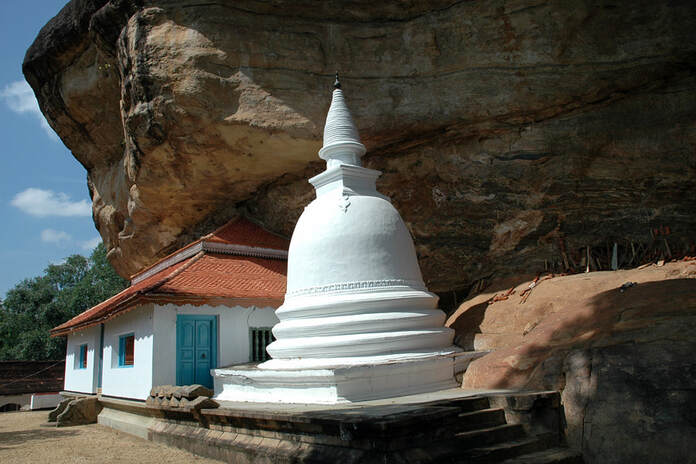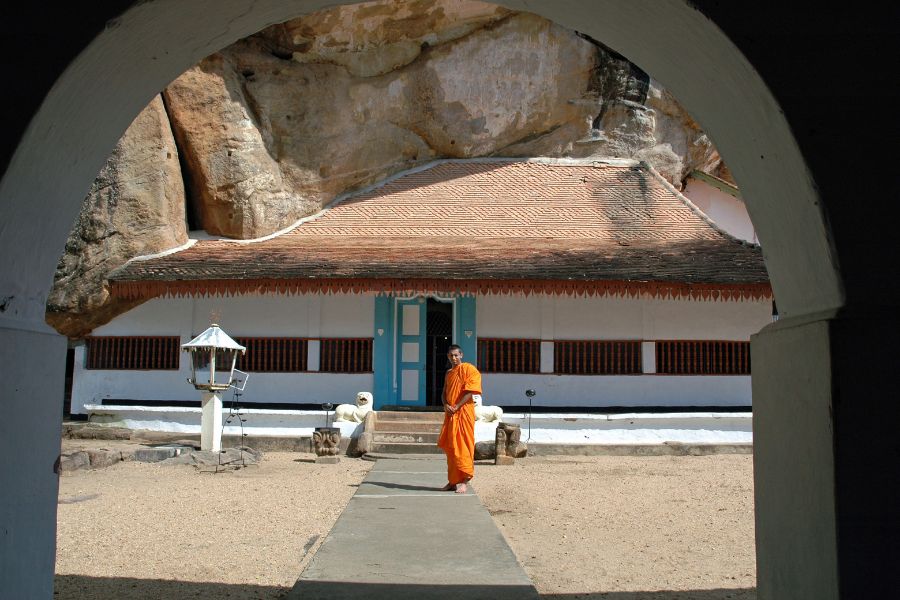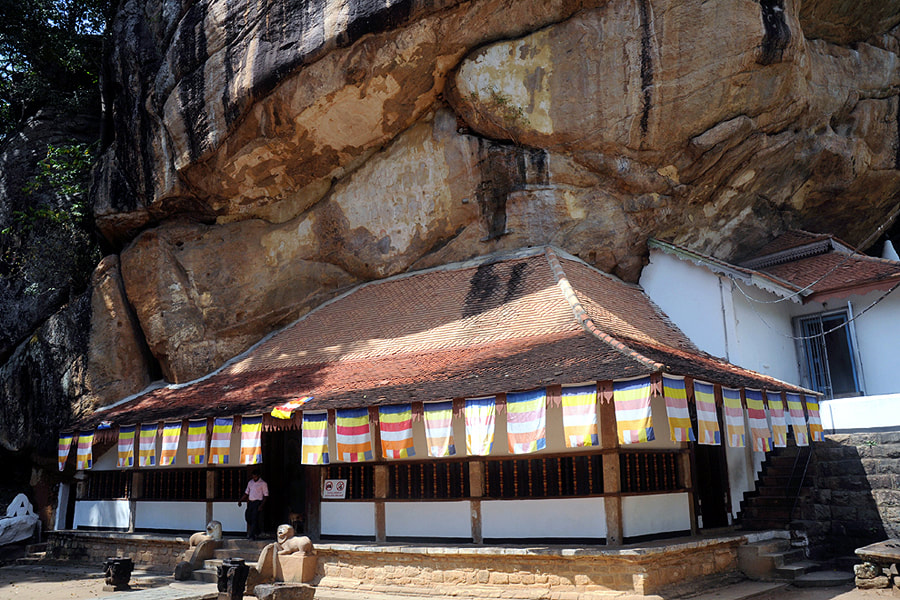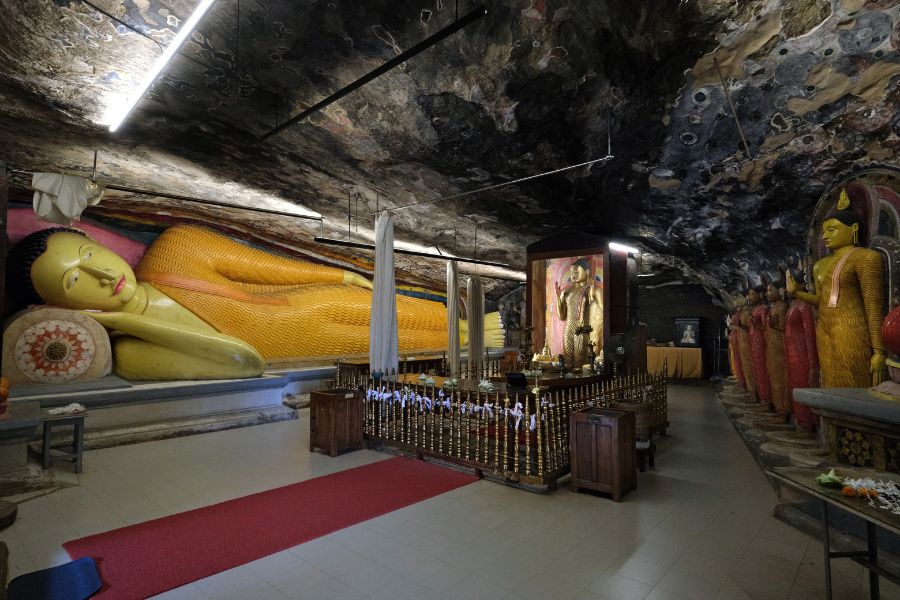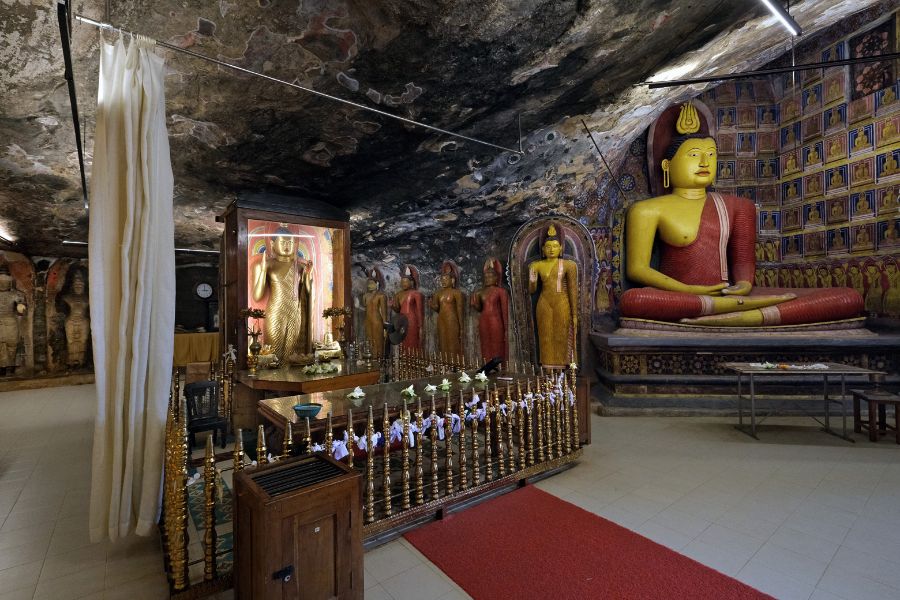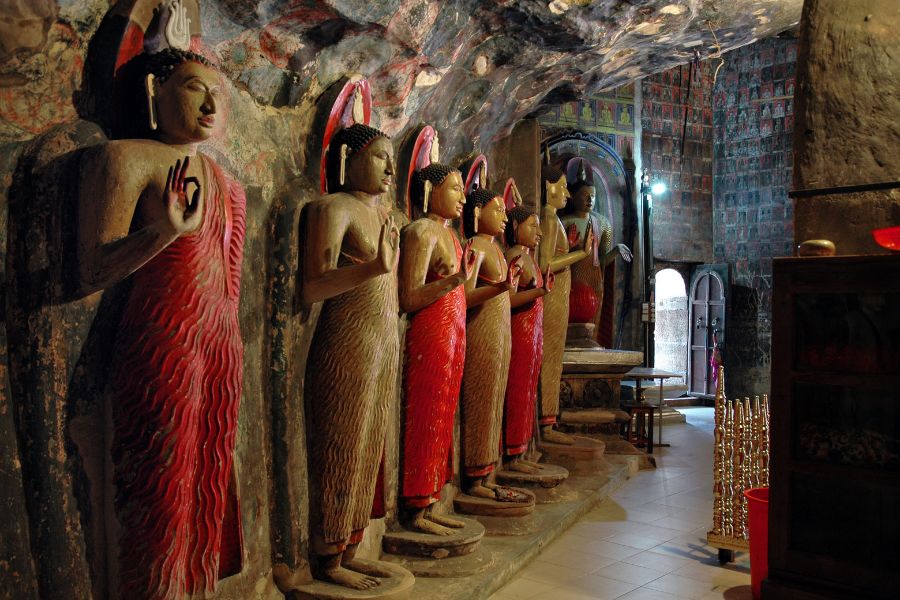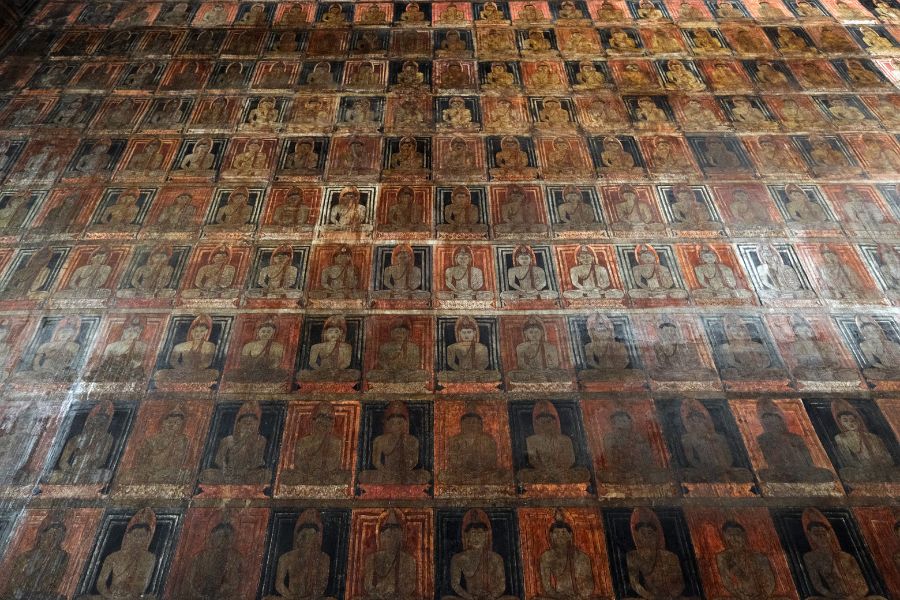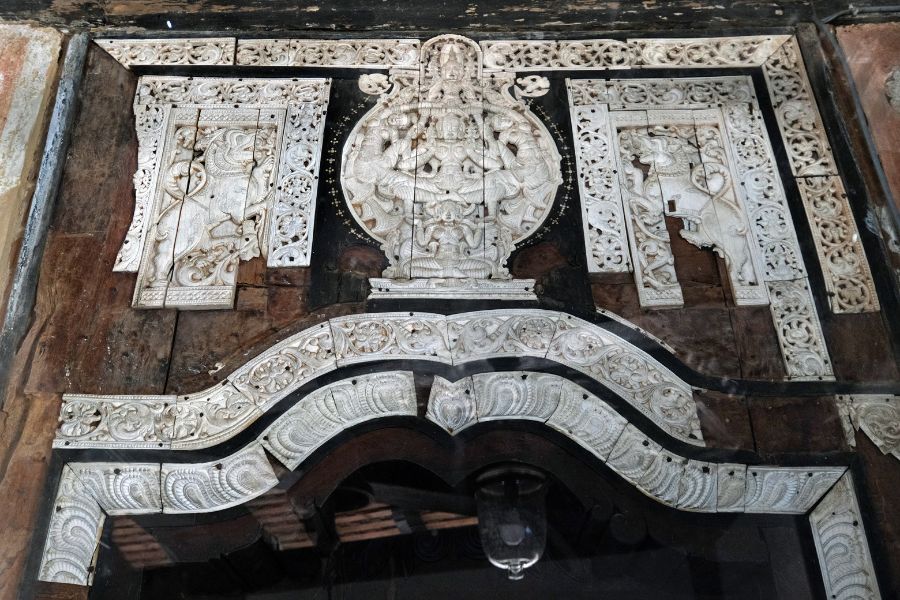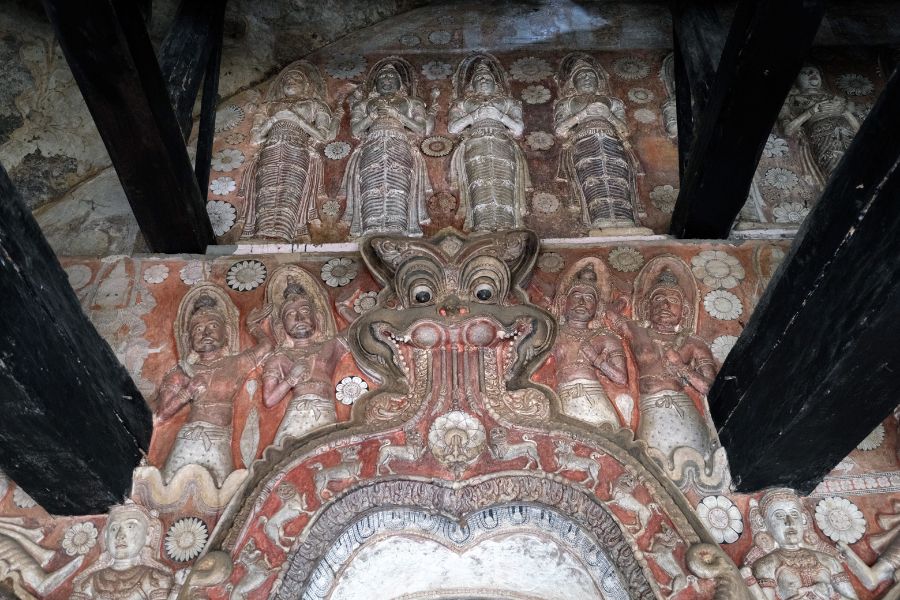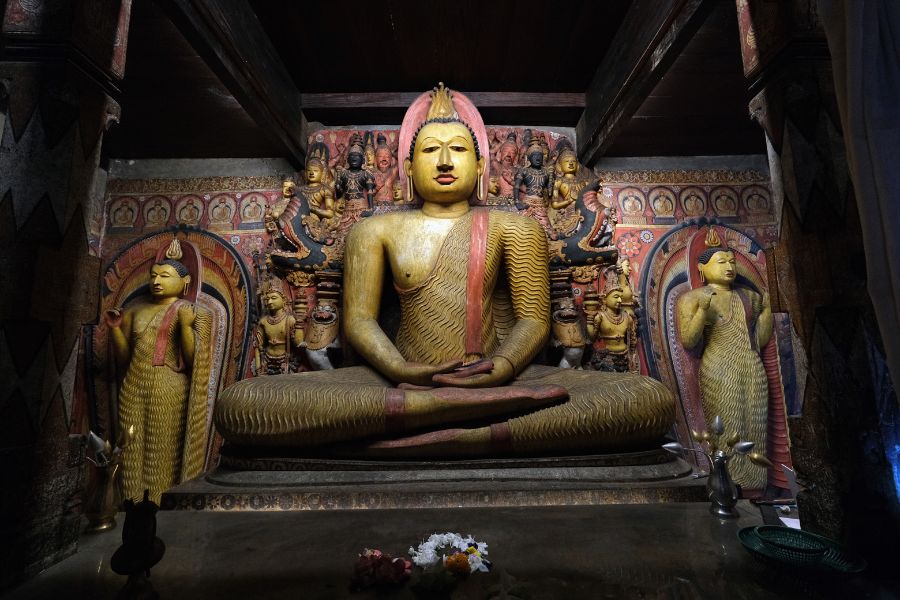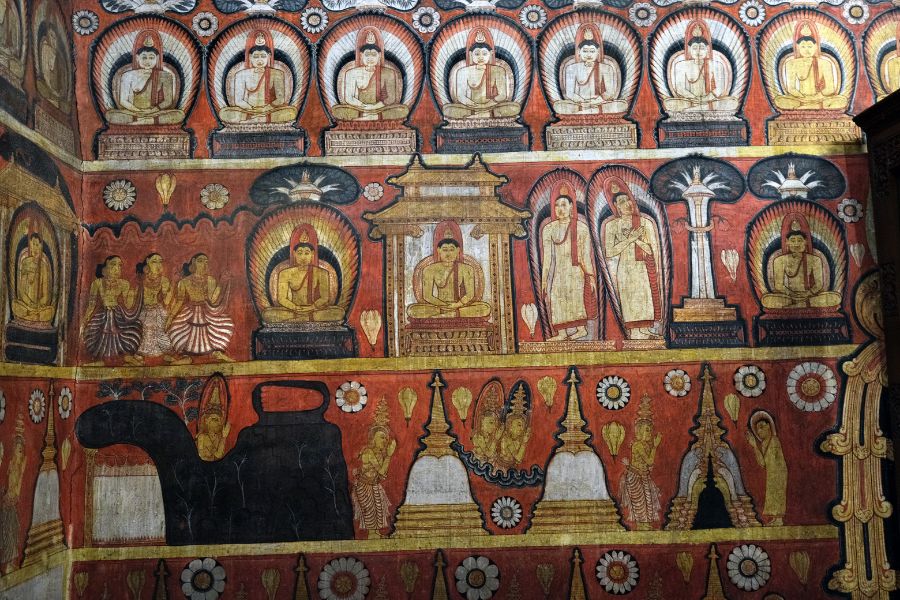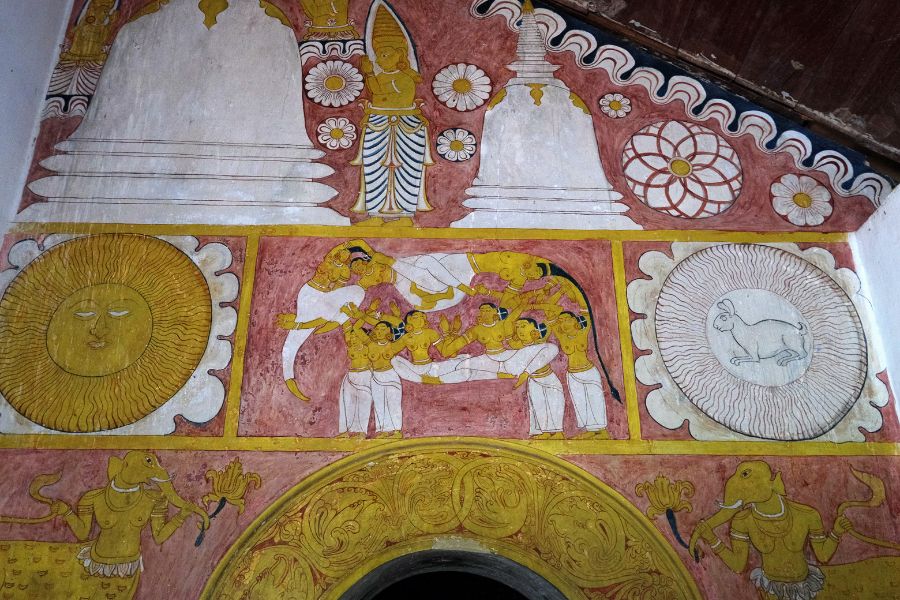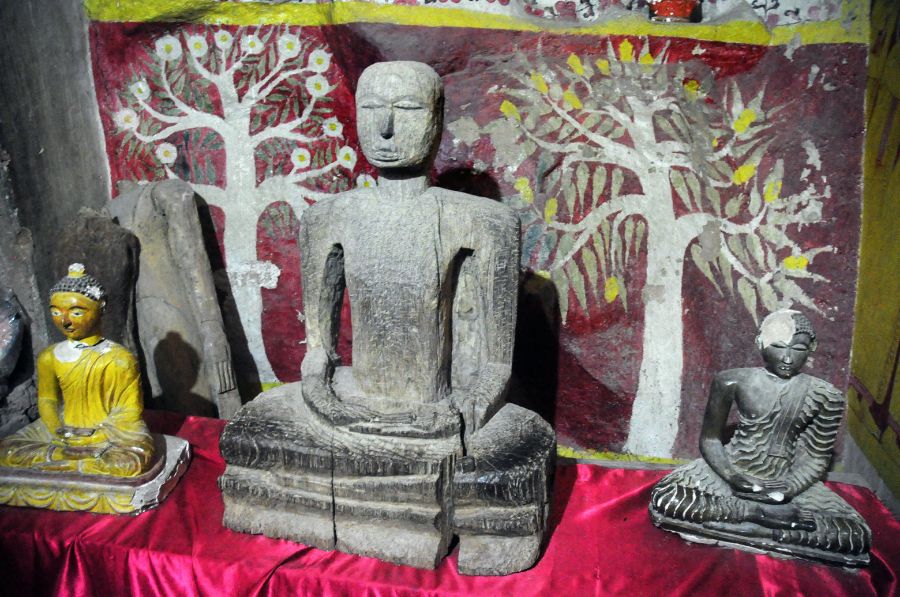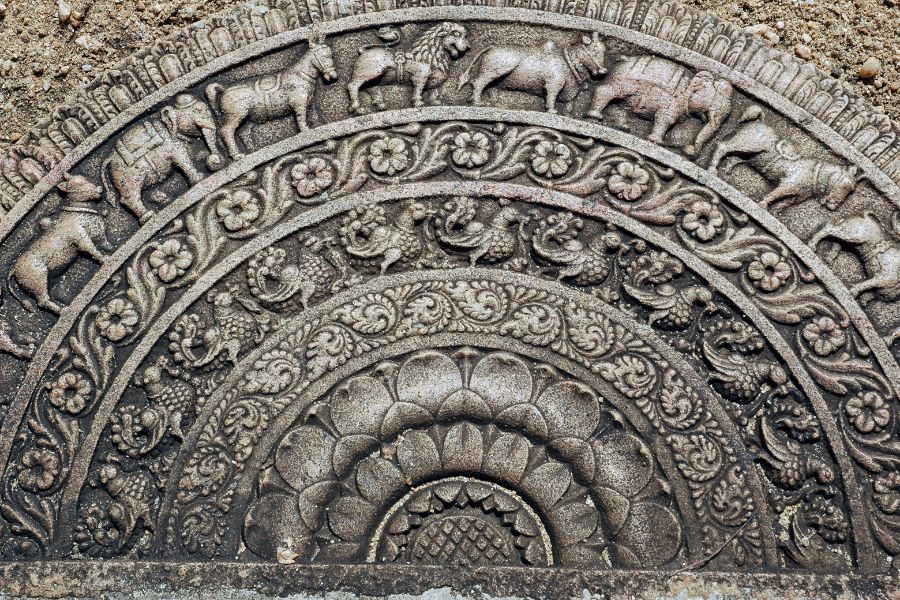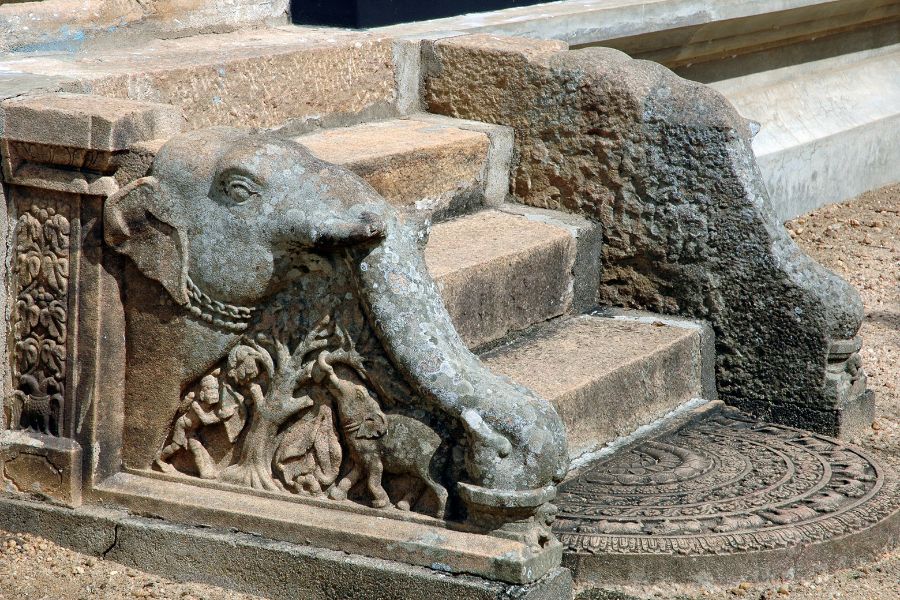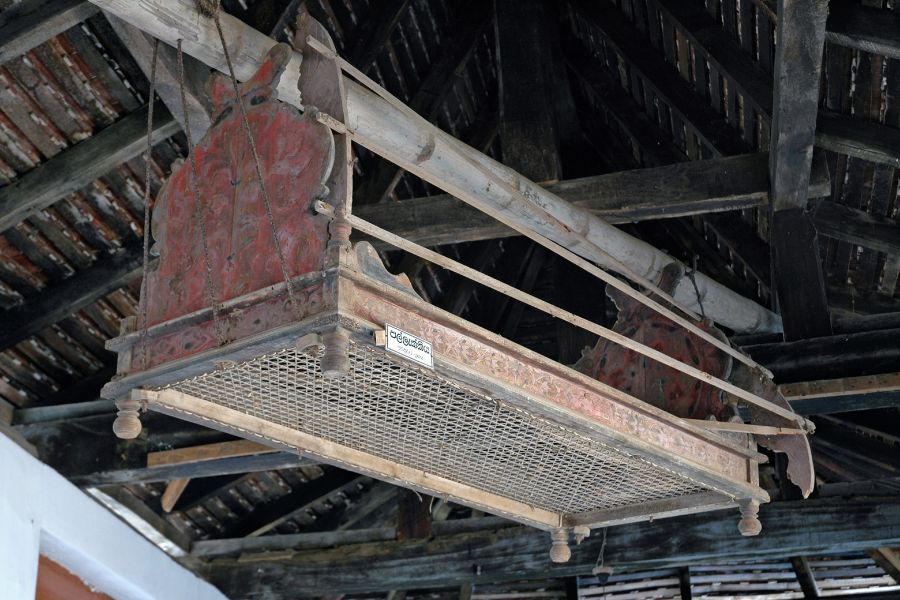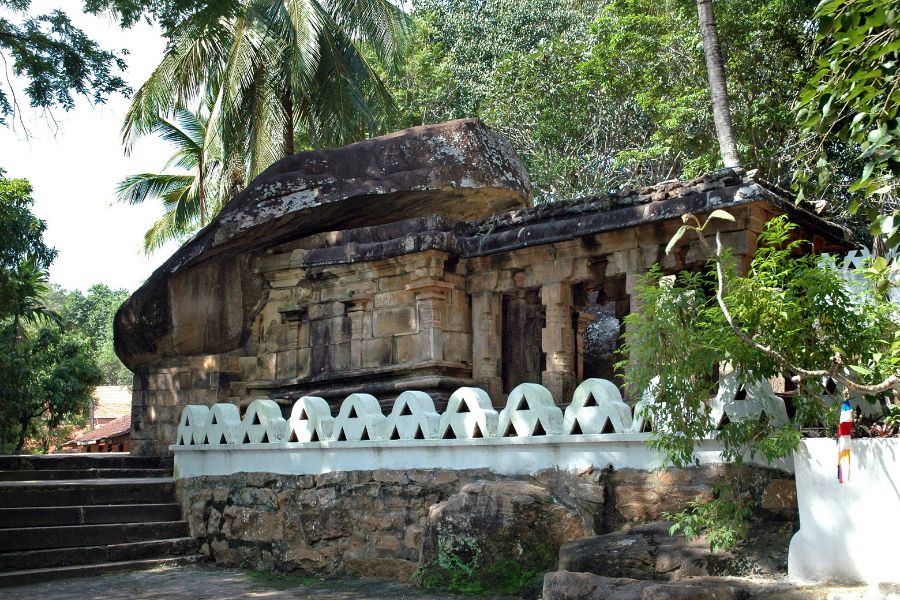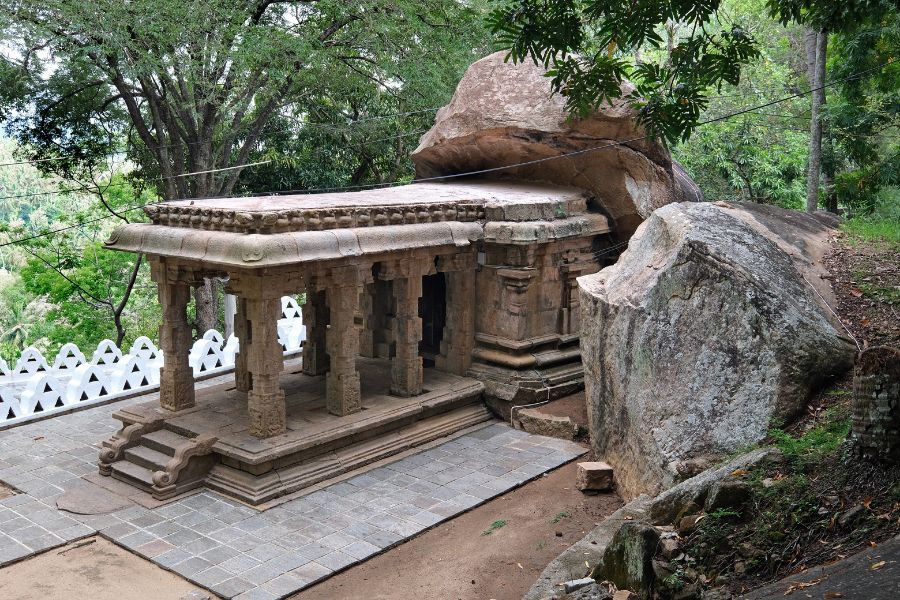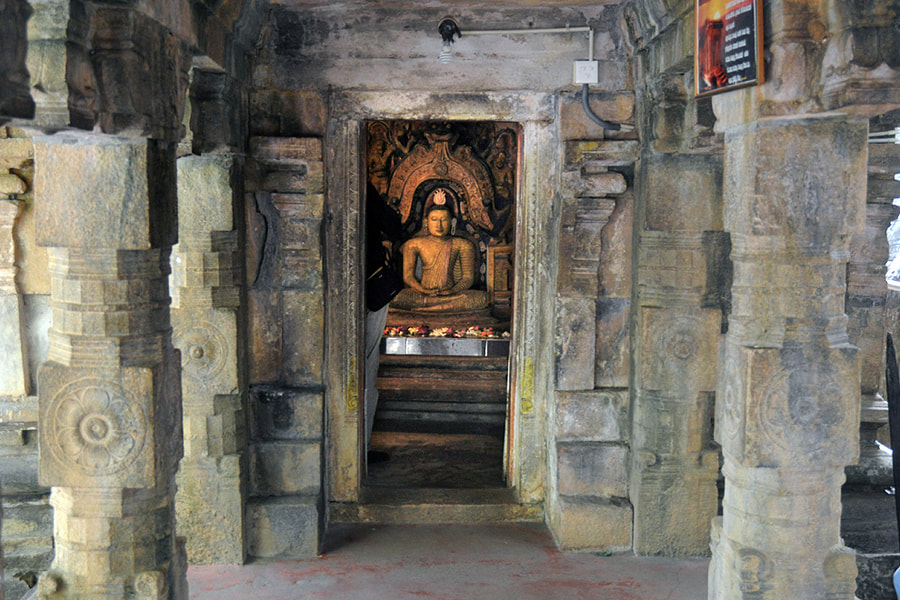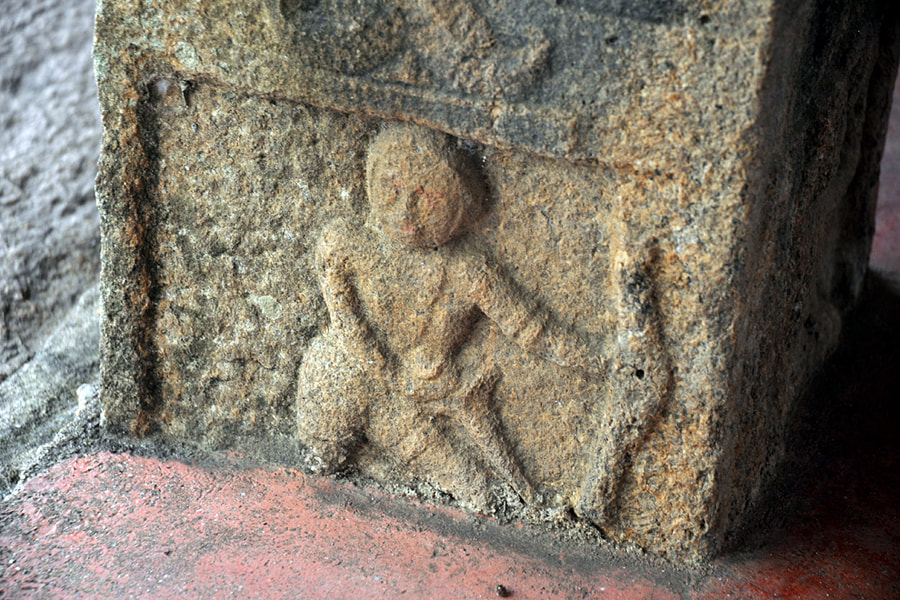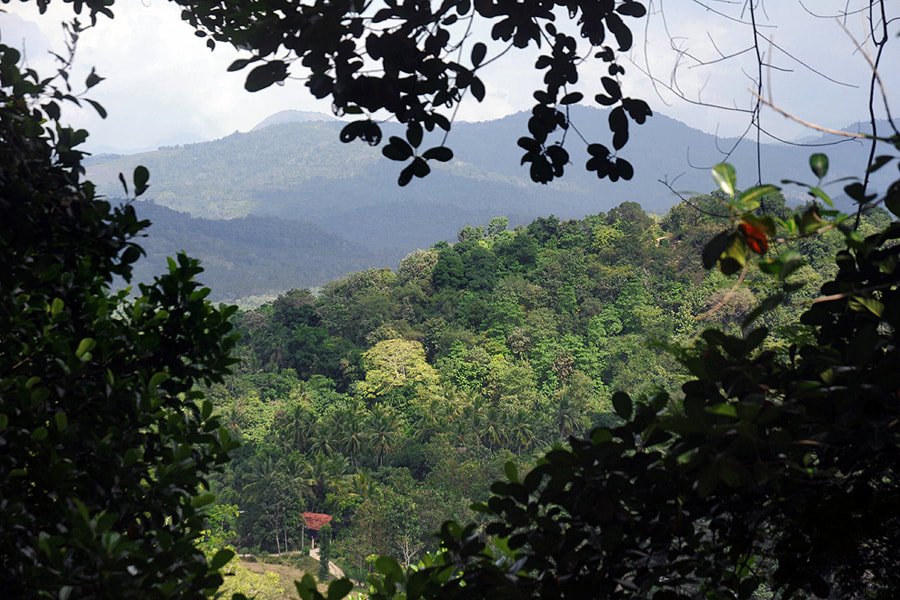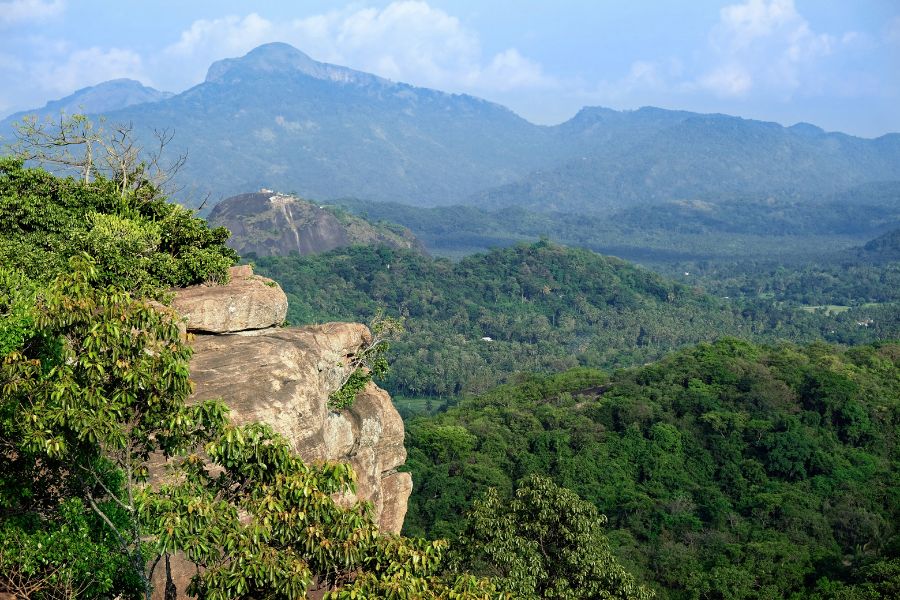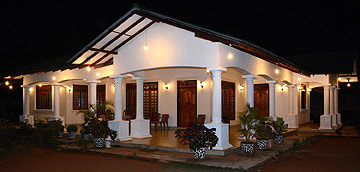The Ridivihara (Reediviharaya) in Ridigama is the most significant heritage site in the northeastern foothills of Sri Lanka’s central highlands. In fact, the temple is one of the most rewarding cultural destinations of the entire island nation. It’s less known to foreign travellers only because of its location away from the main roads and tourist routes. There are several reasons to count Ridivihara among the greates attractions of Sri Lanka. It has one of Sri Lanka’s largest painted caves in the Kandyan monastic style, second only to Dambulla. It also has a small but quite distinctive and enchanting Polonnaruwa-period stone hall which is not in ruins. The Ridivihara looks back to 2000 years of monastic tradition. There is rarely any other monastery in the world that has been inhabited by monks for such a long period. Furthermore, this monastery is a vivid and genuine example of Sri Lanka’s Buddhist traditions. Foreigners are welcome and treated as guests, not as fundraising potential.
The former name translates to “silver monastery” and the latter to “silver village”. The name refers to silver ore found in the main cave, which helped to finance the construction of the giant stupa of Ruwanweliseya in Anuradhapura in the 2nd century BC. Out of gratitude, King Dutthagamani donated the caves to the Buddhist Sangha.
The former name translates to “silver monastery” and the latter to “silver village”. The name refers to silver ore found in the main cave, which helped to finance the construction of the giant stupa of Ruwanweliseya in Anuradhapura in the 2nd century BC. Out of gratitude, King Dutthagamani donated the caves to the Buddhist Sangha.
Location - oldest monastery - History - Lower Cave - Upper Cave - Rear Cave - Moonstone - Yak temple - Pahangala
Location
Ridi Vihara is the name of the monastery 2 km south of the village of Ridigama, which is 18 km (11 miles) northeast of the district capital Kurunegala. With the Ridiviharaya, known as Silver Monatery in English, the village is home to one of the most important and yet comparatively unknown places of interest in Sri Lanka.
|
Since Ridigama is located in the Kurunegala district, not far from the Arankale excavations, it can be considered to be in the northwest of the country. But because Dambulla is only 30 kilometers away and because the Ridiviharaya was founded by the most famous Anradhapura king, the historical site can also be counted as a place of interest of the region touristically known as Cultural Triangle. However, Ridigama can also be assigned to the mountainous region as it lies in the northwesternmost foothills and therefore has a different landscape character than the flat west and north with their monasteries in groups of granite boulders that stand out there.
|
Ridi Viharaya - among the world's oldest living monasteries
As an important hillcountry ties monastery, the Ridiviharaya has close ties with the main monastery of Malwatta in the highland metropolis of Kandy. The chief monk of Malwatta is titled Mahanayakathera, he is head of the largest branch of the order in Sri Lanka. The current Mahanayakathera of Malwatta in Kandy (date of writing this articele: 2023) was previously the chief monk of the Ridivihara for many years. The current chief monk was his student; he often works in Kandy with his teacher and head of the order leader. Traditionally, the Ridivihara represents one of the order's deputy leaders, titled Anunayakathera. After Malwatta, the Ridivihara can be counted as one of the most respected monasteries of this main branch of the Syam-Nikaya, which is widespread and predominant in the highlands.
The Ridivihara can be considered one of the oldest monasteries in the world, but with the restriction that it was temporarily abandoned in the first half of the 18th century. If you subtract those 50 years or so, the monastery still has a history of over 2,100 years.
Outside Sri Lanka, earlier Buddhist monasteries are only found in India, but they have all been abandoned. The oldest Buddhist monastery in the world is certainly in Sri Lanka. But in addition to Ridivihara, which was abandoned for a few years, there are other places that can lay claim to the record, especially Dambulla. Dimbulagala is probably the oldest hermit settlement continuously inhabited by monks. The first monastery to be founded in Sri Lanka was the Mahavihara in Anuradhapura, according to the Mahavansa Chronicle. But in the east of the country, the Buddhangala Monastery claims to have been founded by a princess on the run already a century prior to the founding of the Mahavihara. Both latter monasteries were abandoned by the monks after the invasion of Kalinga Magha in the 13th century at the latest, and Buddhangala was only revived again in the 20th century.
The Ridivihara can be considered one of the oldest monasteries in the world, but with the restriction that it was temporarily abandoned in the first half of the 18th century. If you subtract those 50 years or so, the monastery still has a history of over 2,100 years.
Outside Sri Lanka, earlier Buddhist monasteries are only found in India, but they have all been abandoned. The oldest Buddhist monastery in the world is certainly in Sri Lanka. But in addition to Ridivihara, which was abandoned for a few years, there are other places that can lay claim to the record, especially Dambulla. Dimbulagala is probably the oldest hermit settlement continuously inhabited by monks. The first monastery to be founded in Sri Lanka was the Mahavihara in Anuradhapura, according to the Mahavansa Chronicle. But in the east of the country, the Buddhangala Monastery claims to have been founded by a princess on the run already a century prior to the founding of the Mahavihara. Both latter monasteries were abandoned by the monks after the invasion of Kalinga Magha in the 13th century at the latest, and Buddhangala was only revived again in the 20th century.
History of the Silver Temple
Ridigama means “silver village” and Ridivihara means “silver monastery”. The background of this name is the history of the monastery's origins. When the Sinhalese national hero Dutthagamani became king in the reconquered capital of Anuradhapura, he soon began building the famous Ruwanweliseya, arguably the most venerated dagoba of Sri Lanka. But due to the absent of slave labour, the huge undertaking also required financing the salaries and building materials. A discovery of silver vain in the lower cave of today's Silver Monastery occured just in time for the king allowing him to finance his ambitious projects. As a thank you, he is said to have founded a remote monastery at the site of the discovery.
Inscriptions of other early Anuradhapura kings attest to the great antiquity and continuing importance of the site. Because the Ridiviharaya was located away from the big cities and traffic routes, it was not abandoned even during the many times of unrest that plagued the island. This is why the Buddhist monastery today looks back on such a incomparably long monastic history. Only a few communities of hermits, such as those on Mount Dimbulagala in Sri Lanka or the Jains in Sravana Belgola in southern India, can point back to an equally long or perhaps longer tradition.
Legend has it that Dutthagamani donated a partly gold-plated Buddha statue for the cave in which the silver vein was discovered. It’s blieved to be the statue that now stands in the central niche of the lower cave, behind protective glass. If true, this would be by far the oldest Buddha statue in the world. But it is unlikely that this dating is correct, because in early Buddhism Buddha was not depicted physically. It was only under Hellenistic influence that the first Buddha statues were created in northwest India, not before the 1st century AD. Nevertheless, an older Buddha figure tradition in Sri Lanka cannot be ruled out, as the historical chronicles expressly mention a golden Buddha figure among the relics and offerings that Dutthagamani had buried under the huge Ruwanweliseya, i.e. as early as the 2nd century BC. Stylistic characteristics allow to date back the Buddha statue of the Risiciharaya to the Anuradhapura period, but this period lasted for more than a thousand years. In fact, the statue probably dates from between the 3rd and 7th centuries. However, it is sometimes claimed that it is an older import from India.
Inscriptions of other early Anuradhapura kings attest to the great antiquity and continuing importance of the site. Because the Ridiviharaya was located away from the big cities and traffic routes, it was not abandoned even during the many times of unrest that plagued the island. This is why the Buddhist monastery today looks back on such a incomparably long monastic history. Only a few communities of hermits, such as those on Mount Dimbulagala in Sri Lanka or the Jains in Sravana Belgola in southern India, can point back to an equally long or perhaps longer tradition.
Legend has it that Dutthagamani donated a partly gold-plated Buddha statue for the cave in which the silver vein was discovered. It’s blieved to be the statue that now stands in the central niche of the lower cave, behind protective glass. If true, this would be by far the oldest Buddha statue in the world. But it is unlikely that this dating is correct, because in early Buddhism Buddha was not depicted physically. It was only under Hellenistic influence that the first Buddha statues were created in northwest India, not before the 1st century AD. Nevertheless, an older Buddha figure tradition in Sri Lanka cannot be ruled out, as the historical chronicles expressly mention a golden Buddha figure among the relics and offerings that Dutthagamani had buried under the huge Ruwanweliseya, i.e. as early as the 2nd century BC. Stylistic characteristics allow to date back the Buddha statue of the Risiciharaya to the Anuradhapura period, but this period lasted for more than a thousand years. In fact, the statue probably dates from between the 3rd and 7th centuries. However, it is sometimes claimed that it is an older import from India.
The large Lower Cave
The Lower Cave (“Patha Viharaya”), in which the silver discovery was made, was one of the numerous “caves” under overhanging rocks in Sri Lanka that were long used as dwellings by monks living in the solitude of the forest. They were originally only protected from the outside, if at all, with wooden shelters. Like so many such cave dwellings, over time the Lower Cave was converted into a cult room. When the monks moved into other accommodations, a kind of image house was established in the cave, in addition to a stupa, as has been the case since the middle Anuradhapura period and at the latest since the Polonnaruwa period. Buddha statues were venerated in such cave image houses, especially by pilgrims. A long row of standing Buddhas, predominantly in the gesture of "starting the wheel of teaching", in the rear diagonal of the Lower Cave, recognizable by the design with a layer of lacquer on a textile plaster around the stone body, only dates from the Kandyan period.
The overall appearance of the cave, similar to Dambulla, is determined by the younger Kandy period, in which also the huge Buddha figure of the the size of the cave wall as well as the large murals were added. After Dambulla and Degaldoruwa, the Ridivihara can claim to have the most illustrous Kandyan paintings.
On the back wall you can also see statues depicting King Dutthagamani and Hindu deities. Such Hindu guardians of Buddhist shrines were very popular in the Kandyan period.
On the back wall you can also see statues depicting King Dutthagamani and Hindu deities. Such Hindu guardians of Buddhist shrines were very popular in the Kandyan period.
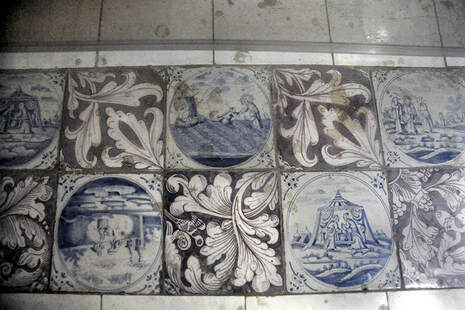
In the lower cave of the Silver Monastery, in addition to Buddhism and Hinduism, we come across another religion that hardly anyone would expect here, namely Christianity. The special feature in front of the 9 m long reclining Buddha in the Lower Cave also dates from the Kandy period, namely Dutch tiles that a Dutch ambassador had presented to the king of Kandy, perhaps with missionary motives. Many of these tiles show typical rural scenes from Holland. But some have biblical motifs. From the Old Testament you can see the creation of man, the fall of man, the Noah’s Flood and Moses in front of the burning bush. Paul can be seen several times being lowered in a basket from the city wall of Damascus. Jesus himself is also depicted here in a Buddhist monastery, for example walking across the Sea of Galilee.
The filling of the upper door frame to the lower cave was an unusually large ivory carving called “Panch Nari Getaya”, which is now on display next to the entrance. The name suggests what is depicted, namely five women who are twisted together as if in a knot. However, you can only recognize them upon closer inspection, because together they appear in the shape of a vase. This is a typical example of the illusionistic motifs popular in the Kandyan period. This “vase” made up of female figures is flanked by two lion figures.
Upper Cave
The smaller Upper Cave Temple (“Uda Viharaya”) dates entirely from the Kandy period. It is traced back King Kirthi Sri Rajasingha, who had the ordination line from Siam introduduced to revive Buddhism in Sri Lanka and who reestablished numerous highland monasteries, including the Silver Monastery, who since than belong to the reformed so-called Syam-Nikaya (Siamese Order-branch). In the Upper Cave you can see a central seated figure of the Buddha, framed by a Makara arch, which shows a somewhat unusual arrangement of the elements in that the Makara heads are curved outwards. Figures of Hindu gods are also placed in this cave.
It is entirely painted with murals in the Kandyan style, including illusionistic motifs of animals that are otherwise found in palace complexes in southern India and Sri Lanka, but less so in religious shrines. On the pedestal of the larhe statue can be seen the “Thri Singha Rupaya” on the front, three lions, all of which have the same head. The figure of a cow and an elephant, which have the same head, is an even more typical iluusionist painting at the pedestal. If the viewer's eye interprets the trunk as a horn, the image "tips" from the elephant's head to the bovine's head.
Rear Cave
Another typical illusionist painting can be seen above the entrance to a very small cave next to the Upper Cave. This painting depicts the “Nawanari Kunjaraya”, nine girls arranged so that together they form the shape of an elephant, a theme known also from palaces in South India. Inside this smalles cave is an unusual old wooden carving of the Buddha. With its simple shapes it appears very archaic, probably because it was not completed. Bats sometimes hang under the ceiling of this small cave room.
Moonstone of Ridigama
Leaving this complex of interiors, one sees a moonstone in front of the staircase to the Upper Cave, which has the exact arrangement of animals as in the classical Anuradhapura period. But it was carved comes only in the Kandyan period. This moonstone is insofar unique, as in the Kandyan period triangular moonstones were created with a circle of animals in the middle and, no longer semicircular ones rows of animals like in the Anuradhapura period. What you see here in the Silver Monastery is, so to speak, a “classical” moonstone.
In front of the caves there is a small white stupa under an overhanging rock that is quite picturesque. Huge wasp nests hang on the rocks. Locals claim that the wasps protect the temple by attacking any visitor who comes with bad intentions.
In the courtyard in front of the caves you can see the chief monk's ancient litter under the roof, near the entrance.
In the courtyard in front of the caves you can see the chief monk's ancient litter under the roof, near the entrance.
Yak Fruit Temple
Outside the cave area lies another extraordinary sight of the Silver Monastery, namely the “Waraka Welandu Lena”. It is simply called Yak Temple or Yak Fruit Temple. Such a fruit is said to have been eaten here by Indragupta, a hermit who lived in Sri Lanka in the early days of Buddhism and found enlightenment.
So he became an “Arahat” or “Arahant,” a Buddhist saint. Orthodox Theravada Buddhists believe that only in the first centuries of Buddhism did some people “awaken” like the Buddha, i.e. become Arahats, i.e. find Nirvana. In Sri Lanka's chronicles such Arahats are mentioned by name. Places where such a “saint” lived, of course, attract pilgrims.
So he became an “Arahat” or “Arahant,” a Buddhist saint. Orthodox Theravada Buddhists believe that only in the first centuries of Buddhism did some people “awaken” like the Buddha, i.e. become Arahats, i.e. find Nirvana. In Sri Lanka's chronicles such Arahats are mentioned by name. Places where such a “saint” lived, of course, attract pilgrims.
The Yak Temple is worth seeing just because of its visual appearance. The rear main cell is half inserted into a natural granite block, over which a palm tree still rises. But this building is also remarkable in terms of art history. It dates from the Polonnaruwa period, around the 12th century. The combination of a cave-like cell for the main portrait with a larger pillared porch is actually known from Hindu art on the Indian mainland. Comparable ensembles in Polonnaruwa, which never achieve the structural integrity of this yak temple, are dedicated to Hindu gods. But in the Yak Temple, a Buddha statue forms the center of the cult cell. It is therefore assumed that a temple originally built for a Hindu deity was later converted into a Buddhist sanctuary.
The pillared porch now has remarkable reliefs on its pillars, predominantly floral motifs, but also dancing girls and even soldiers. The shape of the columns and these motifs are often found in Sri Lanka, less often in the Cultural Triangle than mostly in the highlands, and not in stone but in wood, as in Embekke in the 14th century and of course in Kandy itself. The Yak Temple of the Silver Monastery shows that the architecture of such mostly royal ceremonial halls in the highlands had its models in stone, of which only a few examples like thw Yak temple of Ridigama still survive.
Beyond the Yak temple are the monks' living quarters and one of the guest houses. In 2008, there were three fully ordained monks living here. When time permits, they prove to be exceptionally hospitable to the rare foreign visitors, without any financial ulterior motives. The younger monks are mostly studying in other cities. The chief monk is busy with social projects in the village as well as Sunday schools, a monk training center and a meditation center. As mentioned, he often stays in the main monastery of Malwatta in Kandy.
Beyond the Yak temple are the monks' living quarters and one of the guest houses. In 2008, there were three fully ordained monks living here. When time permits, they prove to be exceptionally hospitable to the rare foreign visitors, without any financial ulterior motives. The younger monks are mostly studying in other cities. The chief monk is busy with social projects in the village as well as Sunday schools, a monk training center and a meditation center. As mentioned, he often stays in the main monastery of Malwatta in Kandy.
Pahangala
Climbing two hundred meters further up the mountain, one comes to the main white stupa of the monastery called “Sarasum Gala Chaitya”. From here there are beautiful views of the surrounding north-eastern mountains. Two circles of ridges seem to protect the monastery in their midst.
On the path between the stupa and the monastery, with a little attention you can see some old stone inscriptions in old Brahmi letters from the Anuradhapura period. There are still many former hermit caves in the surrounding area. A hike of around a mile leads to an escarpment with even better views. The rock is known as Pahangala.
On the path between the stupa and the monastery, with a little attention you can see some old stone inscriptions in old Brahmi letters from the Anuradhapura period. There are still many former hermit caves in the surrounding area. A hike of around a mile leads to an escarpment with even better views. The rock is known as Pahangala.
Since the Silver Monastery was richly gifted with land by the aforementioned Kandyan king Kirthi Sri Rajasingha, it is the main land owner of the region. This also entails obligations towards the local farmers, who turn to the monastery with their problems, for example with irrigation, as in pre-colonial Sri Lanka. Like many of the village monasteries, the Silver Monastery has committed itself to a social role, but this is not without controversy in the Buddhist clergy because of the order's rules, which require isolation from worldly things. Among other things, a library was created for the village of Ridigama by the previous abbot, who, as said, is now the highest cleric of the Malwatta in Kandy (as in 2023). Unlike the politicized monks in the lowlands, the Ridivihara maintains a very conciliatory style in dealing with other religious communities. The Muslim minority is traditionally very strongly represented in Ridigama. The Silver Monastery provided own land for the construction of a mosque.
